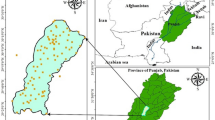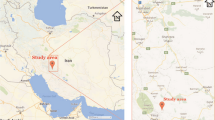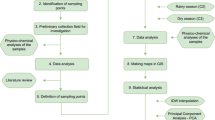Abstract
In several areas of Chhattisgarh, the disintegration of the content of groundwater by the anthropogenic activities is rising at an alarming pace. However, there is still limited information regarding groundwater quality. The present study develops a geostatistical-based water quality index (WQI) and analyzes the spatial variation of contamination zone within the study area. Water samples were collected and tested for different parameters from 55 different locations based on random sampling method. The physio-chemicals properties of water like pH, conductivity, total dissolved solids, calcium, magnesium, bicarbonate, carbonate, sulfate, chloride, nitrate, and fluoride were used for analysis. Pearson Correlation coefficient analysis showed strong and positive correlation between EC, HCO3−, and Cl−. Empirical Bayesian kriging (EBK) is used to interpolate the physio-chemical variables. In EBK interpolation, the lowest Root-Mean-Square Error (RMSE) and the standard error values were calculated for EC, HCO3−, SO4−, NO3−, Ca2+, Mg2+, and F− using K-Bessel model. The lowest RMSE value was calculated for pH (0.952), Cl−(1.016), Na+(0.905), and TH (0.979) using Whittle model of EBK interpolation technique. Results showed that north and north-east of the district are characterized by low groundwater quality and the north-west and central part of the district have very good groundwater quality. The very good WQI is covered by 1989.65 sq km (12.64%) of the study area.








Similar content being viewed by others
Data availability
The datasets used and analyzed during the current study are available from the corresponding author on reasonable request.
References
Alexander AC, Ndambuki J, Salim R, Manda A (2017) Assessment of spatial variation of groundwater quality in a mining basin. Sustainability 9(5):823. https://doi.org/10.3390/su9050823
Bhunia GS, Keshavarzi A, Shit PK, Oman ESE, Bagherzadeh A (2018) Evaluation of groundwater quality and its suitability for drinking and irrigation using GIS and geostatistics techniques in semiarid region of Neyshabur, Iran. Appl Water Sci 8:168. https://doi.org/10.1007/s13201-018-0795-6
BIS (2012) Indian standard specification for drinking water. Bureau of Indian Standards, New Delhi
Chakraborty B, Roy S, Bhunia GS, Sengupta D, Shit PK (2021) Groundwater quality through multi- criteria -based GIS analysis: village level assessment. Groundw Soc. https://doi.org/10.1007/978-3-030-64136-8_6
Chaudhry AK, Kumar K, Alam MF (2019) Groundwater contamination characterization using multivariate statistical analysis and geostatistical method. Water Sci Technol Water Supply 19(5). https://doi.org/10.2166/ws.2019.111
Deshmukh KK (2012) Studies on chemical characteristics and classification of soils from Sangamner area, Ahmednagar district, Maharashtra, India. Rasayan J Chem 5(1):74–85
Dev R, Bali M (2019) Evaluation of groundwater quality and its suitability for drinking and agricultural use in district Kangra of Himachal Pradesh, India. J Saudi Soc Agric Sci 18(4):462–468
El Afly M (2012) Integrated geostatistics and GIS techniques forassessing groundwater contamination in Al Arish area, Sinai, Egypt. Arab J Geosci 5(2):197–215
ElKashouty M (2019) Groundwater quality distribution by geostatistical investigation (GIS), Nile Delta, Northern Egypt. J Environ Chem Ecotoxicol 11(1):1–21. https://doi.org/10.5897/JECE2018.0437
Elumalai V, Brindha K, Sithole B, Lakshmanan E (2017) Spatial interpolation methods and geostatistics for mapping groundwater contamination in a coastal area. Environ Sci Pollut Res Int 24(12):11601–11617. https://doi.org/10.1007/s11356-017-8681-6
Esmaeili A, Moore F (2012) Hydrogeochemical assessment of groundwater in Isfahan province. Iran Environ Earth Sci 67:107–120
Gautam SK, Tziritis E, Singh SK, Tripathi JK, Singh AK (2018) Environmental monitoring of water resources with the use of PoS index: a case study from Subarnarekha River basin, India. Environ Earth Sci 77:70. https://doi.org/10.1007/s12665-018-7245-5
Hughes JM, Koplan JP (2005) Saving lives through global safe water. Emerg Infect Dis 11(10):1636–1637. https://doi.org/10.3201/eid1110.051099 (PMID: 16355504; PMCID: PMC3366765)
Jabal MSA, Abustan I, Rozaimy MR, Al-Najar H (2014) Fluoride enrichment in groundwater of semi-arid urban area: Khan Younis City, southern Gaza Strip (Palestine). J Afr Earth Sci 100:259–266
Jacintha TGA, Rawat KS, Mishra A, Singh SK (2016) Hydrogeochemical characterization of groundwater of peninsular Indian region using multivariate statistical techniques. Appl Water Sci 7(6):3001–3013
Kaur T, Bhardwaj R, Arora S (2016) Assessment of groundwater quality for drinking and irrigation purposes using hydro-chemical studies in Malwa region, southwestern part of Punjab, India. Appl Water Sci 7:3301–3316
Kaymaz SM (2018) Mapping water quality by using geostatistical method (Marmaris Bay, Mugla, Turkey). J Marin Biol Aqua Res 1(1):1–3
Khadri SFR, Pande C, Moharir K (2013) Groundwater quality mapping of PTU-1 watershed in Akola district of Maharashtra India using geographic information system techniques. Int J Sci Eng Res 4:1–17
Kim D, Miranda ML, Tootoo J, Bradley P, Gelfand AE (2011) Spatial modeling for groundwater arsenic levels in North Carolina. Environ Sci Technol. https://doi.org/10.1021/es103336s
Krivoruchko K (2012) Empirical Bayesian kriging-implemented in ArcGIS geostatistical analyst. ESRI Press, Redlands
Krivoruchko K, Gribov A (2014) Pragmetic Baysian kriging for non-stationary and moderately non-Gaussian data. Mathematics of planet earth. Proceedings of the 15th annual conference of the International association and mathematical geosciences. Springer, pp 61–64.
Kumar V, Remadevi V (2006) Kriging of groundwater levels—a case study. J Spat Hydrol 6(1):81–92
Kumar RP, Ranjan RK, Ramanathan AL, Singh SK, Srivastava PK (2015) Geochemical modeling to evaluate the mangrove forest water. Arab J Geosci 8:4687–4702
Machiwal D, Mishra A, Jha MK, Sharma A, Sisodia SS (2012) Modeling short-term spatial and temporal variability of groundwater levelusing geostatistics and GIS. Arab J Geosci 21(1):117–136. https://doi.org/10.1007/s11053-011-9167-8
Majumdar D, Gupta N (2000) Nitrate pollution of groundwater and associated human health disorders. Indian J Environ Health 2:28–39
Manap MA, Nampak H, Pradhan B, Lee S, Sulaiman WNA, Ramli MF (2012) Application of probabilistic-based frequency ratio model in groundwater potential mapping using remote sensing data and GIS. Arab J Geosci. https://doi.org/10.1007/s12517-012-0795-z
Marko K, Al-Amri NS, Elfeki AMM (2014) Geostatistical analysis using GIS for mapping groundwater quality: case study in the recharge area of Wadi Usfan, western Saudi Arabia. Arab J Geosci 7:5239–5252. https://doi.org/10.1007/s12517-013-1156-2
McLeod L, Bharadwaj L, Epp T, Waldner CL (2017) Use of principal components analysis and kriging to predict groundwater-sourced rural drinking water quality in Saskatchewan. Int J Environ Res Public Health 14(9):1065. https://doi.org/10.3390/ijerph14091065 (PMID:28914824; PMCID:PMC5615602)
Mirzaei R, Sakizadeh M (2016) Comparison of interpolation methods for the estimation of groundwater contamination in Andimeshk-Shush Plain, southwest of Iran. Environ Sci Pollut Res 23:2758–2769. https://doi.org/10.1007/s11356-015-5507-2
Moharir M, Pande C, Singh SK, Choudhari P, Kishan R, Jeyakumar L (2019) Spatial interpolation approach-based appraisal of groundwater quality of arid regions. J Water Supply Res Technol Aqua 68(6):431–447
Nema MA, Khare D, Adamowski J, Chandniha SK (2018) Spatio-temporal analysis of rainfall trends in Chhattisgarh state, Central India over the last 115 years. J Water Land Dev 36(I–III):117–128
Nishanthiny SC, Thushyanthy M, Barathithasan T, Saravanan S (2010) Irrigation water quality based on hydrochemical analysis, Jaffna, Sri Lanka. Am-Eur J Agric Environ Sci 7:100–102
Omran EI-E (2012) A proposed model to assess and map irrigation water well suitability using geospatial analysis. Water 4:545–567. https://doi.org/10.3390/w4030545
Prakash O, Datta B (2014) Optimal monitoring network design for efficient identification of unknown groundwater pollution sources. Int J Geomate 6:785–790
Rao DJ, Swami AVVS, Raghu Babu K, Hari BB (2016) Water quality index using gis and suitability for drinking purpose in and around Badvel taluka of Kadapa district, Andhra Pradesh, India. Rasayan J Chem 9(3):444–453
Rawat KS, Singh SK (2018) Water quality indices and GIS-based evaluation of a decadal groundwater quality. Geol Ecol Landsc 2(4):240–255
Rebolledo B, Gil A, Flotats X, Sánchez JA (2016) Assessment of groundwater vulnerability to nitrates from agricultural sources using a GIS-compatible logic multi-criteria model. J Environ Manag 171:70–80
Rehman F, Cheema T, Lisa M, Azeem T, Ali NA, Khan Z, Rehman F, Ur RS (2018) Statistical analysis tools for the assessment of groundwater chemical variations in Wadi Bani Malik area Saudi Arabia. Glob Nest J 20:1–8
Samantara MK, Padhi RK, Sowmya M, Kumaran P, Satpathy KK (2017) Heavy metal contamination, major ion chemistry and appraisal of the groundwater status in coastal aquifer, Kalpakkam, Tamil Nadu, India. Groundw Sustain Dev 5:49–58
Sanders AP, Messier KP, Shehee M, Rudo K, Serre ML, Fry RC (2012) Arsenic in North Carolina: public health implications. Environ Int 38:10–16. https://doi.org/10.1016/j.envint.2011.08.005
Singh CK, Shashtri S, Mukherjee S (2011) Integrating multivariate statistical analysis with GIS for geochemical assessment of groundwater quality in Shiwaliks of Punjab, India. Environ Earth Sci 62:1387–1405
Singh VK, Bikundia DS, Sarswat A, Mohan D (2012) Groundwater quality assessment in the village of Lutfullapur Nawada, Loni, district Ghaziabad, Uttar Pradesh, India. Environ Monit Assess 184(7):4473–4488
Tiwari AK, Lavy M, Amanzio G, De Maio M (2017) Identification of artificial groundwater recharging zone using a GIS-based fuzzy logic approach: a case study in a coal mine area of the Damodar Valley India. Appl Water Sci 7(8):4513–4524. https://doi.org/10.1007/s13201-017-0603-8
UNICEF (2019) Progress on household drinking water, sanitation and hygiene 2000–2017. Special focus on inequalities. New York: United Nations Children’s Fund (UNICEF) and World Health Organization 2019.
Verma P, Singh PK, Sinha RR et al (2020) Assessment of groundwater quality status by using water quality index (WQI) and geographic information system (GIS) approaches: a case study of the Bokaro district, India. Appl Water Sci 10:27
WHO (2011) Guidelines for drinking-water quality. World Health Organization
Yadav KK, Gupta N, Kumar V, Sharma S, Arya S (2015) Water quality assessment of Pahuj river using water quality index at Unnao Balaji, MP, India. Int J Sci Basic Appl Res 19(1):241–250
Yadav KK, Gupta N, Kumar V, Choudhary P, Khan SA (2018) GIS-based evaluation of ground water geochemistry and statistical determination of the fate of contaminants in shallow aquifers from different functional areas of Agra city, India: levels and spatial distributions. RSC Adv 8:15876–15889
Acknowledgements
The authors show their kind acknowledgment to the Dept. of Geography, Raja N. L. Khan Women’s College (Autonomous), and Department of Geology & Geophysics, Indian Institute of Technology (IIT), Kharagpur, West Bengal, India for their laboratory facilities and kind encouragement.
Funding
This research was supported by the Department of Geography, Raja N. L. Khan Women’s College (Autonomous), affiliated to Vidyasagar University, Midnapore, West Bengal, India. The author (P. K. Shit) grateful acknowledges West Bengal DSTBT for financial support through R&D Research Project Memo no. 104(Sanc.)/ST/P/S&T/ 10G-5/2018).
Author information
Authors and Affiliations
Contributions
G. S. Bhuni conceptualized and planned the study, analyzed the data, prepared the maps, and interpreted the results. P. K. Shit reviewed and edited the manuscript. All authors have read and approved the final manuscript.
Corresponding author
Ethics declarations
Conflict of interest
The authors declare that they have no competing interests.
Ethical approval
Not applicable.
Consent to participate
Not applicable.
Consent for publication
Not applicable.
Additional information
Publisher's Note
Springer Nature remains neutral with regard to jurisdictional claims in published maps and institutional affiliations.
This article is part of a Topical Collection in Environmental Earth Sciences on Groundwater quality and contamination and the application of GIS, guest edited by Narsimha Adimalla and Hui Qian.
Rights and permissions
About this article
Cite this article
Bhunia, G.S., Shit, P.K. Appraisal of groundwater contamination and spatial variation using geostatistical modeling in Surguja district of Chhattisgarh, India. Environ Earth Sci 80, 760 (2021). https://doi.org/10.1007/s12665-021-10003-2
Received:
Accepted:
Published:
DOI: https://doi.org/10.1007/s12665-021-10003-2




